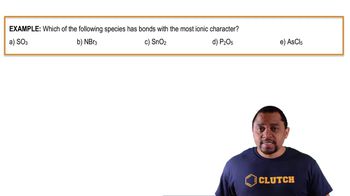(b) Using these partial charges and the atomic radii given in Figure 7.8, estimate the dipole moment of the molecule.
A major challenge in implementing the 'hydrogen economy' is finding a safe, lightweight, and compact way of storing hydrogen for use as a fuel. The hydrides of light metals are attractive for hydrogen storage because they can store a high weight percentage of hydrogen in a small volume. For example, NaAlH4 can release 5.6% of its mass as H2 upon decomposing to NaH(s), Al(s), and H2(g). NaAlH4 possesses both covalent bonds, which hold polyatomic anions together, and ionic bonds. (c) Based on electronegativity differences, predict the identity of the polyatomic anion. Draw a Lewis structure for this ion.
 Verified step by step guidance
Verified step by step guidance
Verified video answer for a similar problem:
Key Concepts
Electronegativity

Ionic and Covalent Bonds

Lewis Structures

(c) The measured dipole moment of BrCl is 0.57 D. If you assume the bond length in BrCl is the sum of the atomic radii, what are the partial charges on the atoms in BrCl using the experimental dipole moment?
A major challenge in implementing the 'hydrogen economy' is finding a safe, lightweight, and compact way of storing hydrogen for use as a fuel. The hydrides of light metals are attractive for hydrogen storage because they can store a high weight percentage of hydrogen in a small volume. For example, NaAlH4 can release 5.6% of its mass as H2 upon decomposing to NaH(s), Al(s), and H2(g). NaAlH4 possesses both covalent bonds, which hold polyatomic anions together, and ionic bonds. (b) Which element in NaAlH4 is the most electronegative? Which one is the least electronegative? Which element in NaAlH4 is the least electronegative?
A major challenge in implementing the 'hydrogen economy' is finding a safe, lightweight, and compact way of storing hydrogen for use as a fuel. The hydrides of light metals are attractive for hydrogen storage because they can store a high weight percentage of hydrogen in a small volume. For example, NaAlH4 can release 5.6% of its mass as H2 upon decomposing to NaH(s), Al(s), and H2(g). NaAlH4 possesses both covalent bonds, which hold polyatomic anions together, and ionic bonds. (d) What is the formal charge on hydrogen in the polyatomic ion?
Structures A, B, and C show the connectivity of the atoms in three different molecules that are isomers of C3H4O. By completing the Lewis structures of these molecules, complete the information in the following table:
Isomer A Isomer B Isomer C
Number of single bonds
Number of double bonds
Number of triple bonds
Number of nonbonding pairs
The triiodide ion, I3-, exists, whereas the corresponding ion with fluorine, F3-, does not. The I3- ion has a linear structure in which two outer I atoms are each bonded to a central I atom. Although I3- is a known ion, F3- is not.
c. Which of the following statements about the existence of I3- versus the nonexistence of F3- is or are true?
i. The Lewis structure of I3- shows 12 electrons around the central I atom.
ii. Elements from the second row of the periodic table generally do not form hypervalent molecules and ions.
iii. An I atom can form a hypervalent molecule or ion more readily than an F atom because of the larger size of the I atom.
